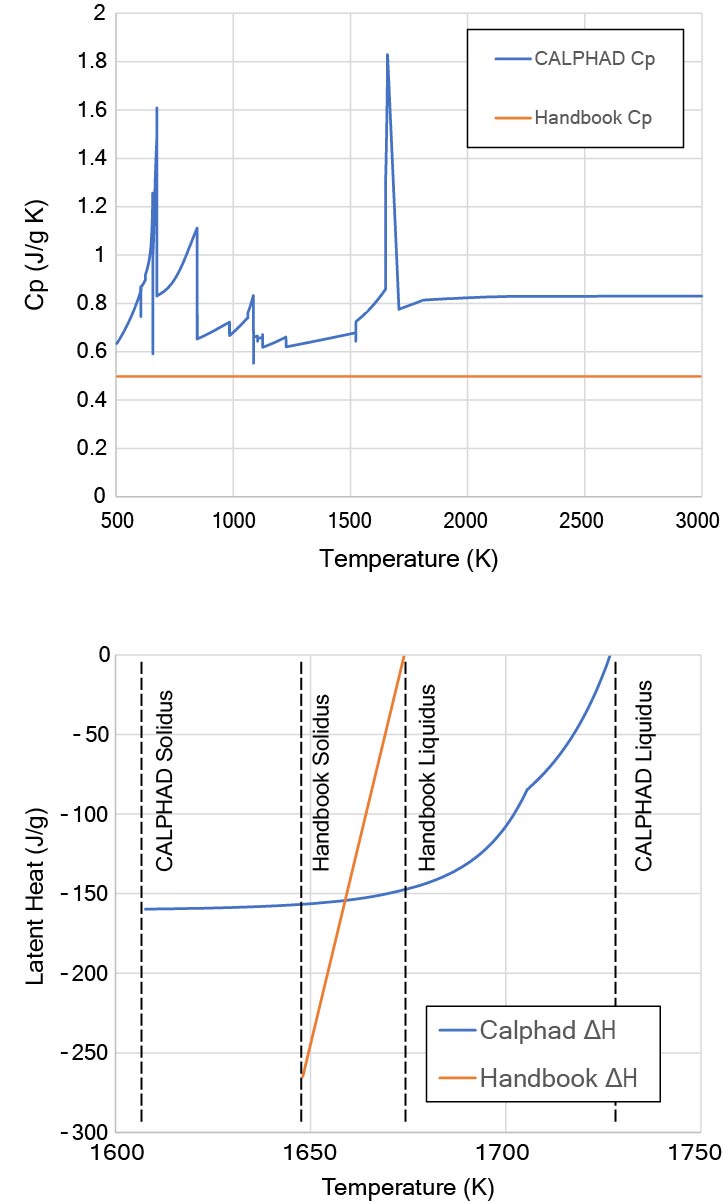design for additive manufacturing synopsis demo video
Applications to Additive Manufacturing
Additive manufacturing, also known as 3D printing of materials, is an innovative process with a lot of research going into the printability of metal alloys. During additive manufacturing of metals, extremely high cooling rates and thermal cycling in the build layer can lead to different material properties than traditional cast or wrought materials.
Thermo-Calc can be used to simulate this highly non-equilibrium process and aid in the design of new alloys suited to additive manufacturing.
Calculate the following as a function of material chemistry and temperature:
-
Thermophysical properties such as heat capacity, enthalpy, and density under non-equilibrium conditions arising from rapid cooling for input into finite element codes
-
Microsegregation during solidification
-
Precipitate evolution and growth during heating and cooling cycles
-
Selecting temperatures for optimal post-build heat treatments
Application Examples
Thermo-Calc has many applications to Additive Manufacturing. Below are three such examples.
Improving Finite Element Modeling with CALPHAD Data
The accuracy of finite element (FE) simulations depends in part on the material property data used by the code. For example, to predict the size, shape, and temperature of the laser melt pool, FE codes need the latent heat and heat capacity of the material. Handbooks are a common source of data, but these typically do not have temperature-dependent data for industrial alloys or data for novel materials. Temperature-dependent data can be calculated using Thermo-Calc for specific chemical compositions of interest.
These figures show a comparison of handbook values and CALPHAD calculated values of Cp (top) and ΔH (bottom) for a 316L Stainless Steel (recalculated from Smith et al. Comput. Mech. 2016).

Capturing the Effects of Rapid Solidification
Rapid solidification, typical of additive manufacturing processes, can lead to solute trapping where solute may be incorporated into the solid phase at a concentration significantly different from that predicted by equilibrium thermodynamics. These effects influence microsegregation, solidification morphology, and the emergent microstructure length scales.
The Scheil Solidification Simulation Calculator in Thermo-Calc includes a model that considers solute trapping in the primary phase for calculations that have a high solidification speed, the Solute Trapping model. The model is based on the main assumption that the primary phase is the only dendrite forming phase within which solute trapping is induced by high solidification speed. The resulting solute trapping also affects composition and amount of other solid phases.
This figure shows a Scheil Solidification Simulation for an Al-Si-Mg alloy using the Solute Trapping model compared with a Classic Scheil Solidification Simulation and equilibrium. The plot shows that the Solute Trapping model is closer to equilibrium as the solidification progresses.

Predicting Optimal Post-build Heat Treatments
During precipitation heat treatment of additively manufactured 625 parts, the deleterious delta phase can precipitate faster than in wrought 625, leading to degradation of properties. Zhang et al (Acta Mater. 2018) have used Thermo-Calc and the Precipitation Module (TC-PRISMA) to predict the precipitation kinetics of the delta phase for nominal feedstock compositions, as well as the compositions measured at dendrite boundaries.
Both simulations, shown in the figures, predict that a stable MC carbide forms, followed by some gamma double prime (γ″). Delta (δ) phase then forms at the expense of the γ″. Because of segregation during solidification, γ″ and δ phase both precipitate much more quickly in the interdendritic region due to the increased Nb and Mo. Delta phase is predicted to start forming around 1 hour, compared with 10 hours for the wrought material. These calculations give insight to the reason why the conventional stress-relief heat treatment is not suitable, and can be used to identify a suitable heat treatment to both homogenize and stress relieve the part, while avoiding deleterious phases.

Learn More about Applications to Additive Manufacturing

Improving Metal Additive Manufacturing with Integrated Materials Modeling
Watch now

Applications of CALPHAD-based tools to additive manufacturing
Read now

Development of Non-Equilibrium Thermodynamic Tools for Additive Manufacturing
Read now

Effect of the Process Atmosphere Composition on Alloy 718 Produced by Laser Powder Bed Fusion
Read now

Degradation of AlSi10Mg powder during laser based powder bed fusion processing
Read now

An integrated computational materials engineering-anchored closed-loop method for design of aluminum alloys for additive manufacturing
Read now

Simulation of TTT Curves for Additively Manufactured Inconel 625
Read now

Applying computational thermodynamics to additive manufacturing
Read now

Application of finite element, phase-field, and CALPHAD-based methods to additive manufacturing of Ni-based superalloys
Read now

Additive Manufacturing of 17-4 PH Stainless Steel: Post-processing Heat Treatment to Achieve Uniform Reproducible Microstructure
Read now

Toward an integrated computational system for describing the additive manufacturing process for metallic materials
Read now


Let Us Help You
Find the Right Products
design for additive manufacturing synopsis demo video
Source: https://thermocalc.com/solutions/solutions-by-application/additive-manufacturing/
Posted by: harrisonriseed.blogspot.com

0 Response to "design for additive manufacturing synopsis demo video"
Post a Comment